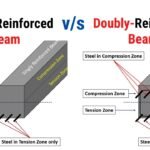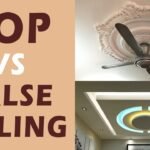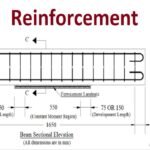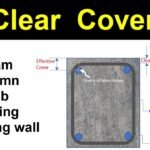Quick answer (for busy readers)
Pick gypsum board ceiling if you want a clean finish, faster installation, better fire safety, and easier maintenance.
Pick POP ceiling (Plaster of Paris ceiling) if you want rich curves, deep mouldings, heavy design work, and lower material costs.
Details, costs, pros, and cons below.
What Are These False Ceiling Materials?
POP (Plaster of Paris) is calcium sulphate hemihydrate. It is mixed with water on site and applied by hand over a mesh and framing to form the false ceiling or cornices. It sets quickly and can be moulded or carved into different shapes.
Gypsum board (also called gypsum plasterboard) is a factory-made panel with a gypsum core and paper liners. Boards come in standard, moisture-resistant (MR), and fire-resistant (FR) variants. They are screwed to a metal framework, joints are taped and finished, then painted.

POP vs Gypsum – Head-to-Head Comparison
| Factor | POP Ceiling | Gypsum Board Ceiling |
|---|---|---|
| Finish quality | Depends on workmanship. Can be very smooth if done by skilled workers. | Consistently smooth factory-made surface with fewer undulations. |
| Design flexibility | Excellent for curves, domes, ornate cornices, medallions. | Good for planes, steps, coffers, and simple curves using layered boards. |
| Installation speed | Slower. Wet process with more curing time. | Faster. Dry process with boards and screws. |
| Mess at site | More dust and waste during application. | Cleaner and more predictable installation. |
| Fire performance | Fair, depends on thickness. | Strong. FR boards can achieve 30–240 minutes in tested systems. |
| Moisture resistance | Can sag or crack if damp; needs paint/primer protection. | MR and FRMR boards offer better performance in kitchens and bathrooms. |
| Repairs | Skilled patching required; large repairs may show. | Easy to cut, replace, and re-finish specific areas. |
| Service access | Harder, monolithic structure. | Easier; cut-and-patch or use access panels. |
| Weight | Similar for typical thicknesses. | Light panels with engineered framing. |
| Cost in India | Usually cheaper per sq ft for plain designs. | Slightly higher, varies by city and board type. |
POP vs Gypsum Ceiling Cost in 2025 (India)
| Ceiling Type | Typical Price (₹/sq ft) | Notes |
|---|---|---|
| POP | ₹95–₹105 + GST | For simple, plain ceilings. Heavy designs cost more. |
| Gypsum – Standard | ₹110–₹125 + GST | Standard boards with A-grade channels. |
| Gypsum – Premium | ₹120–₹145 + GST | Premium boards and channels for better life. |
| Market-wide range | ₹55–₹300 | Price varies based on design complexity, layers, lighting, and location. |
Some basic gypsum ceilings may cost ₹75–₹120/sq ft without design extras.
Performance in Indian Homes
1) Finish and Aesthetics
- POP ceilings are ideal for rich mouldings and heritage-style cornices.
- Gypsum ceilings create crisp lines, perfect for modern designs with LED coves and recessed lighting.
2) Fire Safety
- Gypsum has chemically bound water that slows heat transfer.
- FR and FRMR gypsum boards can provide tested fire resistance from 30 to 240 minutes.
3) Moisture and Humidity Resistance
- POP absorbs moisture and may crack in damp areas.
- Gypsum MR/FRMR boards perform better in kitchens and bathrooms when installed correctly.
4) Speed and Predictability
- POP is a wet process, slower, and highly skill-dependent.
- Gypsum is a dry process, quicker, and more predictable.
5) Maintenance and Repairs
- POP repairs require artisan skill to match the finish.
- Gypsum repairs are simpler — cut, replace, and repaint.
6) Comfort and Insulation
- Both can improve thermal and acoustic comfort.
- Gypsum can be part of acoustic-rated systems when paired with insulation.
7) Sustainability
- Gypsum is recyclable and considered eco-friendly when sourced responsibly.
Also Read Beam Reinforcement Details in Construction — Complete Practical Guide for Indian Projects
Where Each Ceiling Material Works Best
| Space | Preferred Choice | Reason |
|---|---|---|
| Living room with recessed lights | Gypsum | Clean planes and stable joints. |
| Bedroom with step ceiling | Gypsum | Quick installation and cove lighting integration. |
| Kitchen ceiling | Gypsum MR/FRMR | Better moisture and fire performance. |
| Bathroom/Utility | Gypsum MR/FRMR or PVC | Moisture resistance and service access. |
| Classic hall with domes | POP | Best for ornate, handcrafted shapes. |
| Rental property | Gypsum | Easy repairs and maintenance. |
How Contractors Build Them
POP Ceiling Steps
- Fix GI framing and mesh.
- Mix POP powder with water.
- Apply by hand, level, and finish.
- Cure, dry, sand, and paint.
Gypsum Board Ceiling Steps
- Fix GI channels to slab.
- Screw boards to frame.
- Tape joints, apply compound, and sand.
- Prime and paint.
Pros and Cons
POP Ceiling
Pros:
- Great for sculptural designs.
- Seamless finish when done well.
- Lower material cost for plain ceilings.
Cons:
- Slower, messy installation.
- Prone to moisture damage.
- Repairs can show.
Gypsum Board Ceiling
Pros:
- Fast, clean installation.
- Better fire resistance.
- MR/FRMR options for wet areas.
- Easy repairs.
Cons:
- Complex curves need extra framing.
- Slightly higher cost.
Buying Tips for Indian Homes
- Finalise design first — modern → gypsum, ornate → POP.
- Choose the right gypsum board type (Standard, MR, FR, FRMR).
- Check framing specs — channel gauge and spacing are critical.
- Seal service cut-outs and ensure proper ventilation in wet zones.
- Use branded joint tape and compound.
- Share lighting plans early for proper fixture support.
- Get itemised quotes for framing, boards, jointing, paint, and mouldings.
Common Myths
- “POP is always cheaper” — true for plain ceilings, but not for heavy designs.
- “Gypsum can’t do curves” — it can, but for tight curves POP is better.
- “All gypsum is the same” — wrong; choose MR, FR, or FRMR based on room use.
FAQs
Q1. Which lasts longer in Indian homes?
Both last long with proper installation. Gypsum joints stay stable, while POP may crack if exposed to moisture.
Q2. Is gypsum safe near kitchens?
Yes, with MR or FRMR boards, proper framing, and ventilation.
Q3. What’s the price difference?
POP: ₹95–₹105 + GST; Gypsum Standard: ₹110–₹125 + GST; Gypsum Premium: ₹120–₹145 + GST.
Q4. Which is more fire-safe?
Gypsum, especially FR systems.
Q5. Will POP ceilings crack?
They may, if humidity is high or application is poor.
Q6. Can I mix both?
Yes, many homes use gypsum for the main ceiling and POP for decorative elements.
Q7. How soon can I paint?
Gypsum can be primed quickly after joints dry; POP needs more drying time.
Conclusion
For most modern Indian homes in 2025, gypsum board ceilings are the more practical choice. They are quicker to install, cleaner, and come with moisture-resistant and fire-rated options.
However, POP ceilings still shine when it comes to artistic mouldings, domes, and heritage-style interiors.
Choose based on your budget, room function, design preference, and timeline. Get itemised quotes, use the right board type, and ensure skilled workmanship for a ceiling that lasts years without problems.










